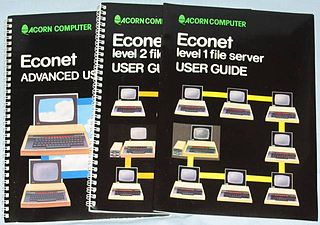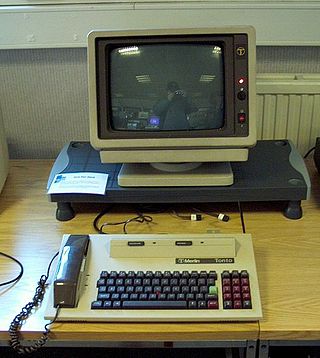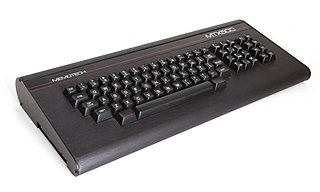The Sinclair QL is a personal computer launched by Sinclair Research in 1984, as an upper-end counterpart to the ZX Spectrum.

The ZX Spectrum is an 8-bit home computer developed and marketed by Sinclair Research. It was first released in the United Kingdom on 23 April 1982. Many official and unofficial clones were released around the world in the following years, most notably in Europe, the United States, and Eastern Bloc countries.
Amstrad was a British electronics company, founded in 1968 by Alan Sugar at the age of 21. The name is a contraction of Alan Michael Sugar Trading. It was first listed on the London Stock Exchange in April 1980. During the late 1980s, Amstrad had a substantial share of the PC market in the UK. Amstrad was once a FTSE 100 Index constituent, but since 2007 has been wholly owned by Sky UK. As of 2006, Amstrad's main business was manufacturing Sky UK interactive boxes. In 2010, Sky integrated Amstrad's satellite division as part of Sky so they could make their own set-top boxes in-house.
Miles Gordon Technology, known as MGT, was a small British company, initially specialising in high-quality add-ons for the ZX Spectrum home computer. It was founded in June 1986 in Cambridge, England by Alan Miles and Bruce Gordon, former employees of Sinclair Research, after Sinclair sold the rights for the Spectrum to Amstrad. They moved to Swansea, Wales, in May 1989, became a public company in July 1989 and went into receivership in June 1990.
Sinclair Research Ltd is a former British consumer electronics company founded by Clive Sinclair in Cambridge. It was originally incorporated in 1973 as Westminster Mail Order Ltd, renamed Sinclair Instrument Ltd, then Science of Cambridge Ltd, then Sinclair Computers Ltd, and finally Sinclair Research Ltd. It remained dormant until 1976, when it was activated with the intention of continuing Sinclair's commercial work from his earlier company Sinclair Radionics, and adopted the name Sinclair Research in 1981.

Econet was Acorn Computers's low-cost local area network system, intended for use by schools and small businesses. It was widely used in those areas, and was supported by a large number of different computer and server systems produced both by Acorn and by other companies.

The ZX Microdrive is a magnetic-tape data storage system launched in July 1983 by Sinclair Research for its ZX Spectrum home computer. It was proposed as a faster-loading alternative to the cassette and cheaper than a floppy disk, but it suffered from poor reliability and lower speed.
Timex Sinclair was a joint venture established in December 1982 between the British company Sinclair Research and Timex Corporation in an effort to gain an entry into the rapidly growing early-1980s home computer market in North America.

Miracle Systems Ltd. were a manufacturer of personal computer peripherals and upgrades, specializing in the Sinclair QL, in the 1980s and early 1990s.

The One Per Desk, or OPD, was an innovative hybrid personal computer/telecommunications terminal based on the hardware of the Sinclair QL. The One Per Desk was built by International Computers Limited (ICL) and launched in the UK in 1984. It was the result of a collaborative project between ICL, Sinclair Research and British Telecom begun in 1983, originally intended to incorporate Sinclair's flat-screen CRT technology.
Tony Tebby is a computer programmer and the designer of Qdos, the computer operating system used in the Sinclair QL personal computer, while working as an engineer at Sinclair Research in the early 1980s.
The CST Thor series of personal computers are Sinclair QL-compatible systems designed and produced by Cambridge Systems Technology during the late 1980s.

The Memotech MTX500 and MTX512 were a range of 8-bit Zilog Z80A based home computers released by the British company Memotech in 1983 and sold mainly in the UK, France, Germany and Scandinavia. Originally a manufacturer of memory add-ons for Sinclair machines, Memotech developed their own competing computer when it was perceived the expansion pack business would no longer be viable.

A BBC Micro expansion unit, for the BBC Micro is one of a number of peripherals in a box with the same profile and styling as the main computer.
The Q40 and Q60 are computer motherboards designed in the late 1990s, based on the Motorola 68040 and 68060 microprocessors respectively and intended to be partially compatible with the Sinclair QL microcomputer. Later these were sold as a fully assembled computer in an AT desktop case.

The history of the personal computer as a mass-market consumer electronic device began with the microcomputer revolution of the 1970s. A personal computer is one intended for interactive individual use, as opposed to a mainframe computer where the end user's requests are filtered through operating staff, or a time-sharing system in which one large processor is shared by many individuals. After the development of the microprocessor, individual personal computers were low enough in cost that they eventually became affordable consumer goods. Early personal computers – generally called microcomputers – were sold often in electronic kit form and in limited numbers, and were of interest mostly to hobbyists and technicians.

The British Broadcasting Corporation Microcomputer System, or BBC Micro, is a series of Microcomputers designed and built by Acorn Computers Limited in the 1980s for Computer Literacy Project of the BBC. Designed with an emphasis on education, it was notable for its ruggedness, expandability, and the quality of its operating system. An accompanying 1982 television series, The Computer Programme, featuring Chris Serle learning to use the machine, was broadcast on BBC2.

Home computers were a class of microcomputers that entered the market in 1977 and became common during the 1980s. They were marketed to consumers as affordable and accessible computers that, for the first time, were intended for the use of a single, non-technical user. These computers were a distinct market segment that typically cost much less than business, scientific, or engineering-oriented computers of the time, such as those running CP/M or the IBM PC, and were generally less powerful in terms of memory and expandability. However, a home computer often had better graphics and sound than contemporary business computers. Their most common uses were word processing, playing video games, and programming.

The SMC-70 is a microcomputer that was produced by Sony and released in September 1982. The system was initially released for general office use in the United States, with the SMC-70G and SMC-70GP designed for professional video generation, for example in cable television applications, and digital video effect generation.











